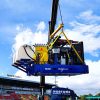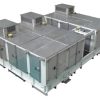Removing concrete is a common challenge across construction, demolition, and maintenance projects. Whether you need to break out damaged concrete, remove coatings, or expose rebar for repairs, choosing the right removal method is essential for safety, efficiency, and protecting underlying structures.
This guide explains the main techniques for concrete removal, their advantages and limitations, and how advanced methods like hydrodemolition are transforming the industry.
Traditional Methods of Concrete Removal
1. Hydrodemolition
Hydrodemolition uses high pressure water jets to remove concrete without damaging the underlying structure or reinforcement.
- Advantages: Precise, vibration-free removal. Significantly increased operator comfort in comparison to manual breaking. Preserves rebar and substrate integrity. Reduces dust and noise. Environmentally friendly, as it minimizes secondary waste. High efficiency removal rates. Robotic machines available for large areas. The same water jetting equipment can be used for scarifying and creating a keyed surface for sprayed repairs.
- Limitations:If full demolition of a concrete structure is needed, explosive or percussive solutions may be commercially better solutions.
2. Chemical Concrete Removal
Chemical agents, such as expansive demolition grouts or acid-based removers, are applied to weaken or dissolve concrete.
- Advantages: Useful for controlled demolition in sensitive environments. Minimal vibration and noise.
- Limitations: Slow process, requires careful handling and disposal of chemicals. Not suitable for large-scale removal or reinforced concrete.
3. Abrasive Blasting
Abrasive blasting uses high-pressure streams of grit or sand to erode concrete surfaces.
- Advantages: Effective for surface cleaning, coating removal, or preparing concrete for repairs.
- Limitations: Generates dust and requires containment. May damage delicate substrates or embedded elements. Cleanup and waste management are necessary considerations.
4. Mechanical Breaking
Mechanical breaking uses jackhammers, breakers, or excavators fitted with hydraulic hammers to fracture and remove concrete.
- Advantages: Widely available, effective for small to medium areas, and suitable for thick concrete.
- Limitations: Generates significant noise, vibration, and dust. Risk of damaging surrounding structures, embedded steel, or re-inforcing bars. Manual handling can be labour intensive and pose safety risks.


Why Choose Hydrodemolition for Concrete Removal?
Hydrodemolition is increasingly preferred for concrete removal in infrastructure, industrial, and civil engineering projects. By using high-pressure water jets, hydrodemolition selectively removes deteriorated or unwanted concrete while leaving sound concrete and embedded steel intact.
- Selective Removal: Targets only damaged or specified areas, reducing the risk of over-breakage.
- Preserves Structure: No microcracking or vibration damage to the remaining concrete or rebar.
- Cleaner Process: Generates less dust and airborne contaminants, improving site safety and environmental compliance.
- Versatile Applications: Suitable for bridges, dams, tunnels, industrial tanks, and more.
Case Studies: Hydrodemolition in Action
-
Flyover Hydrodemolition Demonstration: Hydrodemolition enabled precise removal of concrete from a flyover structure, exposing rebar for repair without damaging the underlying deck. The process minimized disruption and ensured a high-quality repair surface.
Check out the article and pictures. -
Kariba Dam Rehabilitation Project: Hydrodemolition was used to remove deteriorated concrete from the Kariba Dam, one of Africa’s largest dams. The technique allowed for safe, controlled removal in a sensitive environment, preserving the dam’s structural integrity.
Learn more about the Kariba Dam project
Introducing Calder Hydrodemolition Solutions
Calder is a leading provider of hydrodemolition equipment and expertise, supporting projects worldwide. Our advanced systems deliver precise, efficient, and safe concrete removal for a wide range of applications.
- Industry Applications: From infrastructure rehabilitation to industrial cleaning, Calder’s hydrodemolition solutions are trusted by contractors and asset owners globally.
- Expert Support: Our team offers technical advice, equipment rental, and on-site support to ensure your concrete removal project is a success.
Summary
Concrete removal is a critical step in many construction and maintenance projects. While traditional methods like mechanical breaking and abrasive blasting are still used, hydrodemolition offers a safer, cleaner, and more precise alternative – especially for sensitive or large-scale works. You can find our hydrodemolition equipment used in most of the UK’s major infrastructure projects, including HS2.
Need More Information?
If you are planning a surface preparation project or need help selecting equipment, feel free to contact our team for advice. Call +44 1905 751790 or email sales@calder.co.uk.





